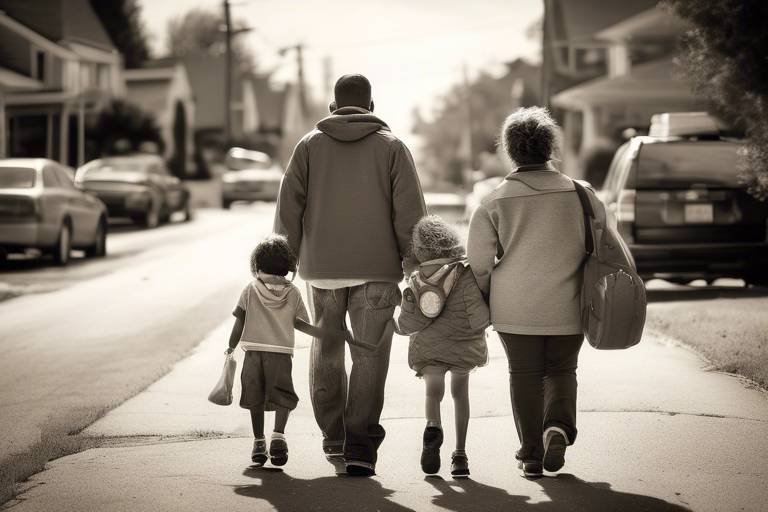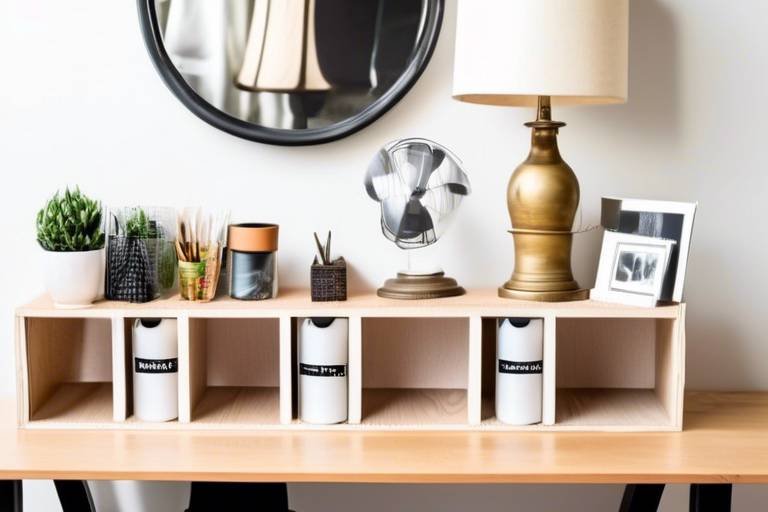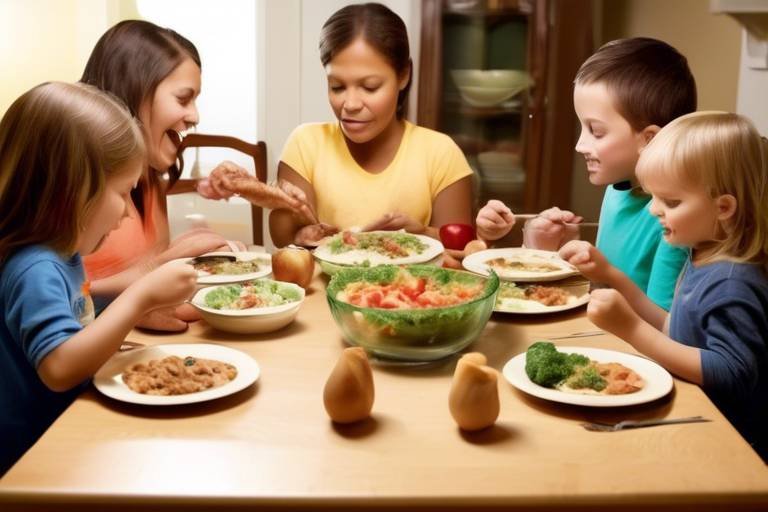Non-Toxic Cleaning Products for Your Family Home
In today's world, where our busy lives often revolve around convenience, the importance of using non-toxic cleaning products cannot be overstated. Have you ever considered what lurks inside those brightly colored bottles under your sink? Many conventional cleaning products are laden with harsh chemicals that can be harmful not just to the environment, but also to our loved ones. By opting for non-toxic alternatives, you’re not just making a choice for cleanliness; you’re creating a healthier home for your family. Imagine walking into your home and breathing in fresh, clean air, free from the noxious fumes of traditional cleaning agents. It's not just a dream; it can be your reality!
Non-toxic cleaning products are designed to be safe for both your family and the planet. They are made with natural ingredients that effectively clean without the risks associated with chemical exposure. This means fewer headaches, less irritation, and a lower chance of allergic reactions for your family members. Additionally, opting for these products can significantly improve your indoor air quality, making your home a sanctuary rather than a source of toxins. So, why not take a step towards a greener lifestyle? By making the switch, you’re not only protecting your family but also contributing to environmental sustainability.
But what exactly makes a cleaning product non-toxic? The key lies in the ingredients. Many conventional cleaners contain a cocktail of harmful substances that can lead to various health issues. Understanding what to avoid is just as crucial as knowing what to embrace. As we delve deeper into this article, we’ll explore the benefits of non-toxic cleaners, identify harmful ingredients to steer clear of, and provide you with practical tips on how to make safe choices for your home.
In the following sections, we will uncover the specific ingredients that can be detrimental to your health and well-being, like phthalates and formaldehyde, and explain why it's crucial to choose products that are free from these harmful chemicals. We will also guide you on how to select safe cleaning products, including what certifications to look for and even how to create your own DIY cleaning solutions using simple, natural ingredients. Are you ready to transform your cleaning routine and embrace a healthier lifestyle? Let’s dive in!
Non-toxic cleaning products offer numerous advantages, including safer indoor air quality, reduced health risks for family members, and environmental sustainability. Discover how these products contribute to a healthier home.
Many conventional cleaning products contain harmful chemicals that can pose risks to your health. This section outlines common toxic ingredients to watch out for and their potential effects on your family.
Phthalates are often used in fragrances and can disrupt hormonal balance. Learn about their sources and why it's crucial to choose phthalate-free cleaning options for your home.
Exposure to phthalates has been linked to various health concerns, including reproductive issues and developmental problems in children. Understanding these risks will help you make informed choices.
Identifying cleaning products that are free from phthalates can be challenging. This section provides tips on reading labels and recognizing trustworthy brands.
Formaldehyde is a common ingredient in many cleaning products and can cause respiratory issues. This section discusses the importance of avoiding products that contain this harmful chemical.
Choosing safe cleaning products involves understanding labels and certifications. This section guides you through the process of selecting non-toxic options that are effective and safe for your family.
Certifications can help you identify truly non-toxic products. Learn about various eco-labels and what they signify regarding safety and environmental impact.
Creating your own cleaning solutions can be a cost-effective and safe alternative. Explore simple recipes using natural ingredients that effectively clean without harmful chemicals.
- What are non-toxic cleaning products? Non-toxic cleaning products are made from natural ingredients that pose minimal risk to health and the environment.
- Are non-toxic cleaners as effective as traditional ones? Yes! Many non-toxic cleaners are just as effective, if not more so, than their chemical-laden counterparts.
- How can I identify harmful ingredients? Always read labels carefully and look for certifications that indicate safety and eco-friendliness.
- Can I make my own cleaning products? Absolutely! Simple ingredients like vinegar, baking soda, and essential oils can create effective cleaning solutions.

Benefits of Non-Toxic Cleaning Products
This article explores the importance of using non-toxic cleaning products, highlighting their benefits, ingredients to avoid, and how to choose safe options for a healthier home environment.
In today's world, the importance of non-toxic cleaning products cannot be overstated. Imagine walking into your home, breathing in fresh air, and knowing that your cleaning supplies are safe for your family and the environment. Non-toxic cleaning products offer a plethora of advantages that go beyond just cleanliness. First and foremost, they significantly improve indoor air quality. Unlike conventional cleaners that release harmful fumes, non-toxic alternatives ensure that the air you breathe is free from hazardous chemicals. This is especially vital for families with children or pets, who are more susceptible to the adverse effects of toxic substances.
Another remarkable benefit is the reduction of health risks. Traditional cleaning products often contain a cocktail of harsh chemicals that can lead to a range of health issues, from skin irritations to respiratory problems. By switching to non-toxic options, you’re not only protecting your loved ones but also contributing to their overall well-being. Plus, many non-toxic products are made from natural ingredients, which means they are less likely to cause allergic reactions or sensitivities. It’s like choosing to eat organic food instead of processed junk—your body will thank you!
Furthermore, non-toxic cleaning products are an essential step toward environmental sustainability. Many conventional cleaners contain phosphates and other harmful ingredients that can pollute waterways and harm aquatic life. By opting for eco-friendly products, you’re making a conscious choice to protect our planet. It’s a win-win situation: you get a clean home, and the Earth gets a little cleaner too!
To illustrate the benefits further, here’s a quick comparison of non-toxic versus traditional cleaning products:
| Feature | Non-Toxic Cleaning Products | Traditional Cleaning Products |
|---|---|---|
| Indoor Air Quality | Improved | Poor |
| Health Risks | Minimal | High |
| Environmental Impact | Positive | Negative |
| Ingredients | Natural | Synthetic |
In conclusion, the benefits of non-toxic cleaning products are clear and compelling. They not only create a safer living environment but also promote a healthier lifestyle for you and your family. So, why not make the switch today? Your home deserves it!
Many conventional cleaning products contain harmful chemicals that can pose risks to your health. This section outlines common toxic ingredients to watch out for and their potential effects on your family.
Phthalates are often used in fragrances and can disrupt hormonal balance. Learn about their sources and why it's crucial to choose phthalate-free cleaning options for your home.
Exposure to phthalates has been linked to various health concerns, including reproductive issues and developmental problems in children. Understanding these risks will help you make informed choices.
Identifying cleaning products that are free from phthalates can be challenging. This section provides tips on reading labels and recognizing trustworthy brands.
Formaldehyde is a common ingredient in many cleaning products and can cause respiratory issues. This section discusses the importance of avoiding products that contain this harmful chemical.
Choosing safe cleaning products involves understanding labels and certifications. This section guides you through the process of selecting non-toxic options that are effective and safe for your family.
Certifications can help you identify truly non-toxic products. Learn about various eco-labels and what they signify regarding safety and environmental impact.
Creating your own cleaning solutions can be a cost-effective and safe alternative. Explore simple recipes using natural ingredients that effectively clean without harmful chemicals.
- Are non-toxic cleaning products as effective as traditional ones? Yes, many non-toxic cleaning products are just as effective, if not more so, than their traditional counterparts.
- How can I identify non-toxic cleaning products? Look for certifications and read ingredient labels carefully. Avoid products with synthetic fragrances and harmful chemicals.
- Can I make my own non-toxic cleaning products? Absolutely! Many common household ingredients like vinegar, baking soda, and lemon juice can be used to create effective cleaning solutions.

Common Harmful Ingredients to Avoid
When it comes to cleaning our homes, we often overlook the ingredients lurking in our favorite products. Many conventional cleaners are packed with harmful chemicals that can pose serious risks to our health and the environment. It's crucial to be aware of these toxic ingredients to protect our families and create a safe living space. Here are some of the most common culprits you should watch out for:
- Ammonia: Found in many glass and surface cleaners, ammonia can irritate the eyes, skin, and respiratory system. Prolonged exposure may lead to chronic respiratory issues.
- Chlorine Bleach: While effective at killing germs, chlorine bleach can release harmful fumes and cause skin irritations. It's particularly dangerous when mixed with other cleaners.
- Phthalates: Often hidden in fragrances, phthalates can disrupt hormonal balance and have been linked to various health issues.
- Formaldehyde: Commonly found in disinfectants and some air fresheners, formaldehyde is a known irritant and potential carcinogen.
- Triclosan: This antibacterial agent can contribute to antibiotic resistance and may disrupt hormone function.
Understanding these ingredients is the first step towards making informed choices. For instance, products containing ammonia or chlorine bleach might seem effective, but the potential health risks can outweigh the benefits. Instead, consider opting for non-toxic alternatives that utilize natural ingredients to achieve cleanliness without compromising your family's health.
Moreover, many of these harmful chemicals can also affect the environment. When they wash down the drain, they can contaminate water supplies and harm aquatic life. So, not only are you protecting your family, but you're also contributing to a healthier planet by avoiding these toxic substances. It's a win-win situation!
As you navigate the cleaning aisle, remember to read labels carefully. Look for products that are transparent about their ingredients and avoid those with long, complex names that are hard to pronounce. The simpler, the better! By making a conscious effort to choose safer products, you’re not just cleaning your home; you’re creating a sanctuary for your loved ones.
In summary, being aware of common harmful ingredients is essential for maintaining a safe and healthy home. By avoiding substances like ammonia, chlorine bleach, phthalates, formaldehyde, and triclosan, you can significantly reduce health risks for your family while also being kinder to the environment. So, the next time you reach for a cleaner, ask yourself: is this really safe for my home?
Q: What are non-toxic cleaning products?
A: Non-toxic cleaning products are made from natural ingredients that do not pose health risks to humans or the environment. They are free from harmful chemicals commonly found in conventional cleaners.
Q: How can I identify non-toxic cleaning products?
A: Look for certifications on the label, such as Green Seal or EcoLogo, and check the ingredient list for simple, recognizable components. Avoid products with long chemical names or those that contain fragrances.
Q: Are DIY cleaning solutions effective?
A: Yes! Many DIY cleaning solutions using ingredients like vinegar, baking soda, and essential oils can be just as effective as commercial cleaners while being safer for your family and the environment.

Phthalates
Phthalates are a group of chemicals commonly used to make plastics more flexible and harder to break. You might be surprised to find out that these sneaky substances are often lurking in products you use every day, particularly in cleaning supplies and personal care items. The main concern with phthalates is their ability to mimic hormones in the body, disrupting the delicate balance of our endocrine system. This can lead to a variety of health issues, particularly for vulnerable populations like children and pregnant women. Imagine your body as a finely tuned orchestra; when phthalates come into play, it’s like introducing a discordant note that throws everything off balance.
These chemicals are primarily found in products with synthetic fragrances, which can make it difficult to avoid them altogether. When you see "fragrance" on a label, it can be a red flag. Unfortunately, manufacturers aren’t required to disclose the specific chemicals used in these fragrances, making it essential for consumers to be vigilant. To help you navigate this maze, here are some common sources of phthalates:
- Air fresheners
- Dish soaps
- Bathroom cleaners
- Shampoos and conditioners
Understanding where phthalates might be hiding in your home is the first step toward creating a safer environment for your family. The potential health risks associated with phthalate exposure are alarming, ranging from reproductive issues to developmental problems in children. It’s essential to be proactive about avoiding these harmful chemicals. By opting for phthalate-free products, you’re not just making a choice for your home; you’re making a commitment to a healthier lifestyle.
Research has shown that phthalates can lead to a variety of health concerns. For instance, studies have linked them to reproductive issues in both men and women, including reduced fertility and complications during pregnancy. In children, exposure to phthalates has been associated with developmental problems, such as behavioral issues and impaired cognitive function. Think of it this way: would you allow a stranger to influence your child’s growth? That’s essentially what’s happening when harmful chemicals invade your home.
Finding cleaning products that are free from phthalates can feel like searching for a needle in a haystack, but it doesn’t have to be that way! Start by educating yourself on how to read labels effectively. Look for products that specifically state they are “phthalate-free.” Additionally, consider brands that prioritize transparency and sustainability. Many companies are now stepping up to the plate by offering eco-friendly options that are not only safe but also effective. When in doubt, do a little research online or consult resources that list trusted brands, ensuring you’re making informed choices for your family’s health.
Q: What are phthalates?
A: Phthalates are chemicals used to make plastics more flexible and are often found in cleaning products, personal care items, and air fresheners.
Q: Why should I avoid phthalates?
A: Phthalates can disrupt hormonal balance and have been linked to various health issues, including reproductive problems and developmental concerns in children.
Q: How can I identify phthalate-free products?
A: Look for labels that specifically state “phthalate-free” and choose brands that are transparent about their ingredient lists.
Q: Are there natural alternatives to phthalate-containing products?
A: Yes! Many natural cleaning products use plant-based ingredients and essential oils instead of synthetic fragrances, making them a safer choice.

Health Risks of Phthalates
Phthalates, often found in numerous household products, are notorious for their potential health risks. These chemicals, primarily used to make plastics more flexible and to enhance fragrances, can wreak havoc on your body, particularly your hormonal system. Imagine your hormones as a finely tuned orchestra; when phthalates enter the picture, it's like someone suddenly starts playing the wrong notes, leading to a cacophony of health issues.
Research has shown that exposure to phthalates can be linked to a variety of serious health concerns. For instance, studies suggest that they may interfere with the endocrine system, which is responsible for hormone regulation. This disruption can lead to reproductive issues, such as reduced fertility in both men and women. Furthermore, children are particularly vulnerable; exposure during critical developmental stages can result in long-term developmental problems.
Some of the specific health risks associated with phthalate exposure include:
- Reproductive Issues: Both men and women may experience fertility problems due to hormonal imbalances caused by phthalates.
- Developmental Problems: Children exposed to phthalates may face challenges in learning and behavior, impacting their overall development.
- Respiratory Issues: Some studies have linked phthalate exposure to asthma and other respiratory problems, particularly in children.
- Obesity: Research indicates a potential connection between phthalate exposure and increased risk of obesity, as these chemicals may disrupt metabolic processes.
Understanding these risks is crucial for making informed decisions about the products you bring into your home. By opting for phthalate-free cleaning products, you not only protect your family's health but also contribute to a safer environment. It's essential to be vigilant and proactive, ensuring that the products you choose are free from these harmful chemicals. Remember, when it comes to your family's health, prevention is always better than cure!
In conclusion, while phthalates may seem like just another technical term, their implications are very real and can significantly affect your family's well-being. By educating yourself and choosing wisely, you can help keep your home a sanctuary of health and safety.
- What are phthalates? Phthalates are chemicals used to make plastics more flexible and are commonly found in various household products, including cleaning supplies.
- How can I avoid phthalates? Look for products labeled as phthalate-free and check ingredient lists for any mention of phthalates.
- Are there safe alternatives to conventional cleaning products? Yes! Many brands now offer non-toxic, eco-friendly cleaning products that do not contain harmful chemicals like phthalates.
- What are the symptoms of phthalate exposure? Symptoms can vary but may include hormonal imbalances, respiratory issues, and developmental problems in children.

Finding Phthalate-Free Products
When it comes to finding phthalate-free cleaning products, the process can sometimes feel like searching for a needle in a haystack. Many products on the market tout their "fresh" scents, but those fragrances often come with hidden dangers in the form of phthalates. To navigate this maze, you need to become a savvy shopper, armed with knowledge and a keen eye for labels. Start by checking the ingredients list on the back of the product. If you see terms like "fragrance" or "parfum," it’s a red flag; these terms can mask the presence of phthalates.
Another effective strategy is to look for products that specifically advertise themselves as phthalate-free. Many brands are now aware of the growing demand for safer cleaning options and are proud to highlight this on their packaging. Additionally, you can seek out reputable brands that focus on natural ingredients and transparency. They often provide detailed information about their formulations on their websites.
To help streamline your search, consider using the following tips:
- Research Brands: Look up reviews and ratings for brands known for their commitment to non-toxic ingredients.
- Use Apps: There are several smartphone apps available that allow you to scan barcodes and check for harmful ingredients.
- Consult Online Resources: Websites dedicated to non-toxic living often provide lists of safe brands and products.
Finally, remember that just because a product is marketed as "green" or "eco-friendly," it doesn’t automatically mean it’s free from phthalates. Always do your homework and don’t hesitate to reach out to manufacturers for clarification. By being proactive and informed, you can create a safer, healthier home for you and your family, free from the hidden dangers of phthalates.
Q: What are phthalates, and why should I avoid them?
A: Phthalates are chemicals used to make plastics more flexible and are often found in fragrances. They can disrupt hormonal balance and are linked to various health issues.
Q: How can I ensure a cleaning product is truly phthalate-free?
A: Always check the ingredients list and look for products that explicitly state they are phthalate-free. Research brands and use apps that help identify safe products.
Q: Are homemade cleaning solutions safe from phthalates?
A: Yes! By using natural ingredients like vinegar, baking soda, and essential oils, you can create effective cleaning solutions without the risk of phthalates.

Formaldehyde
Formaldehyde is a common ingredient lurking in many household cleaning products, and its presence can be quite alarming. This colorless gas, which has a strong, pungent odor, is often used in various cleaning agents, disinfectants, and even some air fresheners. What makes formaldehyde particularly concerning is its classification as a known carcinogen, meaning it has been linked to cancer in humans. When you use products containing formaldehyde, you may unknowingly expose yourself and your loved ones to potential health risks that could lead to serious complications.
One of the primary issues with formaldehyde is its ability to irritate the respiratory system. Prolonged exposure can result in symptoms such as coughing, wheezing, and even asthma attacks. Imagine coming home after a long day, only to be greeted by a cloud of harsh chemicals in the air. It’s not just uncomfortable; it can be downright dangerous, especially for children and individuals with pre-existing respiratory conditions. Furthermore, formaldehyde can cause skin irritation and allergic reactions, making it crucial to be vigilant about the products you choose for your home.
So, how do you know if a cleaning product contains formaldehyde? Unfortunately, it’s not always listed explicitly on the label. Many manufacturers use terms like "formalin" or "methanal," which can make it challenging for consumers to identify these harmful ingredients. This is where being an informed shopper comes into play. Look out for products that specifically advertise themselves as formaldehyde-free or those that carry certifications ensuring their safety. Always read the ingredient list thoroughly, and don’t hesitate to reach out to companies for clarification if needed.
To help you navigate the world of cleaning products, here’s a quick reference table of common household items that may contain formaldehyde:
| Product Type | Potential Sources of Formaldehyde |
|---|---|
| Disinfectants | Some all-purpose cleaners and disinfectant sprays |
| Air Fresheners | Certain aerosol air fresheners and scented candles |
| Fabric Softeners | Some liquid fabric softeners and dryer sheets |
| Household Cleaners | Specific window cleaners and bathroom cleaners |
By being aware of these products, you can make more informed decisions about what to bring into your home. Remember, just because a product is marketed as a cleaning solution doesn’t mean it’s safe for your family. Opting for non-toxic alternatives can significantly reduce your exposure to formaldehyde and other harmful chemicals. Your home should be a sanctuary, not a source of health hazards!
- What are the signs of formaldehyde exposure? Symptoms can include irritation of the eyes, nose, and throat, coughing, wheezing, and skin rashes.
- How can I reduce formaldehyde exposure in my home? Choose formaldehyde-free products, ensure good ventilation, and use air purifiers to help eliminate indoor pollutants.
- Are there safe alternatives to traditional cleaning products? Yes! Consider using vinegar, baking soda, and essential oils for effective cleaning without harmful chemicals.

How to Choose Safe Cleaning Products
Choosing safe cleaning products is like navigating a maze; it can be overwhelming with all the options available. But don't worry! With a little knowledge and awareness, you can make informed decisions that keep your home clean and your family safe. The first step in this journey is to understand product labels. Many brands use clever marketing terms that can be misleading. Words like “natural,” “green,” or “eco-friendly” might sound appealing, but they don’t always mean the product is free from harmful chemicals. Always look for specific certifications that ensure the product meets safety standards.
When you're scanning labels, look for certifications that indicate a product is truly non-toxic. Here are a few reputable certifications to keep an eye on:
- Green Seal: This certification ensures that the product meets strict environmental and health criteria.
- EPA Safer Choice: Products with this label have been evaluated and deemed safer for human health and the environment.
- USDA Organic: While primarily for food, some cleaning products can also be certified organic, indicating they’re made with natural ingredients.
Next, consider the ingredients listed on the back of the bottle. It’s essential to familiarize yourself with common harmful substances. For instance, avoid products containing phthalates, formaldehyde, and chlorine. These chemicals can have adverse effects on your health and the environment. Instead, opt for products that use plant-based ingredients, which are generally safer and just as effective at cleaning.
If you’re feeling adventurous, why not try making your own cleaning solutions? DIY cleaning products can be a fun and cost-effective way to ensure you know exactly what’s in your cleaning arsenal. Simple ingredients like vinegar, baking soda, and essential oils can work wonders for most cleaning tasks. Plus, you can customize the scents to your liking!
Lastly, consider the packaging of the products you choose. Eco-friendly packaging often goes hand-in-hand with non-toxic products. Brands that prioritize sustainability are more likely to use safer ingredients. So, when you’re at the store, look for products that come in recyclable or biodegradable packaging. It’s a small step that can make a big difference for the planet.
Q: Are all natural cleaning products safe?
A: Not necessarily. Just because a product is labeled as natural does not mean it is free from harmful chemicals. Always check the ingredient list and certifications.
Q: Can I trust eco-labels?
A: Yes, many eco-labels are trustworthy, but it's essential to do your research on what each certification means. Look for well-known certifications like Green Seal or EPA Safer Choice.
Q: What are some effective DIY cleaning recipes?
A: You can make a simple all-purpose cleaner by mixing equal parts of water and vinegar. For a fresh scent, add a few drops of your favorite essential oil!

Look for Certifications
When it comes to choosing non-toxic cleaning products for your home, one of the most effective strategies is to . These certifications act as a guiding light, helping you navigate the often confusing world of product labels and ingredient lists. But what do these certifications really mean, and how can they help you make safer choices?
First off, certifications are awarded to products that meet specific safety and environmental standards set by reputable organizations. For example, Green Seal and EPA Safer Choice are two well-known certifications that indicate a product has been evaluated for its environmental impact and safety for human health. When you see these labels, you can breathe a little easier, knowing that the product has undergone rigorous testing and meets stringent criteria.
But the world of certifications can be a bit overwhelming. There are numerous eco-labels out there, each with its own set of criteria. Here’s a quick breakdown of some of the most recognized certifications:
| Certification | Description |
|---|---|
| Green Seal | Products meet strict environmental standards and are safe for human health. |
| EPA Safer Choice | Products are evaluated for safety and environmental impact, ensuring they are safer for families and the environment. |
| USDA Organic | Indicates that a product is made from organic ingredients, free from harmful chemicals. |
| Cradle to Cradle | Products are assessed for their environmental impact across their entire lifecycle. |
Keep in mind that not all products with green claims are created equal. Some may use misleading terms like "eco-friendly" or "natural" without any real backing. That's why it’s crucial to look for these certifications as a reliable way to ensure you’re making a safe choice for your family and the planet.
In addition to checking for certifications, don’t hesitate to do a little research on the brand itself. Many companies that prioritize safety and sustainability will be transparent about their practices and ingredient sourcing. A quick visit to their website can provide valuable insights into their commitment to non-toxic products.
Remember, choosing certified non-toxic cleaning products is not just about cleaning your home; it's about creating a healthier environment for your loved ones. By paying attention to these certifications, you can confidently select products that align with your values and contribute to a sustainable future.
- What are the benefits of using non-toxic cleaning products?
Non-toxic cleaning products improve indoor air quality, reduce health risks, and are better for the environment. - How can I tell if a cleaning product is truly non-toxic?
Look for certifications like Green Seal or EPA Safer Choice on the label, and research the brand’s practices. - Are DIY cleaning solutions effective?
Yes! Many DIY solutions using natural ingredients can effectively clean your home without harmful chemicals.

DIY Cleaning Solutions
In a world where convenience often overshadows health, are emerging as a refreshing alternative. Not only do they allow you to take control of what goes into your home, but they also empower you to create effective cleaners without the harmful chemicals found in many commercial products. Imagine walking into your home and being greeted by the fresh scent of lemon and vinegar rather than the harsh smell of synthetic fragrances. Sounds appealing, right?
Creating your own cleaning products can be both cost-effective and environmentally friendly. With just a few simple ingredients, you can whip up cleaning solutions that tackle everything from kitchen grime to bathroom mildew. The best part? You know exactly what’s in them! Common household items such as baking soda, white vinegar, and essential oils can work wonders when combined correctly. For instance, a mixture of vinegar and baking soda can create a powerful foaming action that helps lift dirt and stains.
Here are a few popular recipes to get you started:
- All-Purpose Cleaner: Combine 1 cup of white vinegar, 1 cup of water, and 10 drops of your favorite essential oil (like tea tree or lavender) in a spray bottle. This solution is perfect for countertops, windows, and even floors.
- Glass Cleaner: Mix 1 cup of water, 1 cup of vinegar, and a few drops of dish soap. Spray on glass surfaces and wipe with a microfiber cloth for a streak-free shine.
- Scrubbing Paste: Combine 1 cup of baking soda with 1/2 cup of liquid Castile soap and a few drops of essential oil. This paste is great for scrubbing sinks, tubs, and even stubborn spots on your stovetop.
When making your own cleaners, it’s essential to remember that not all natural ingredients are created equal. While many are safe and effective, some can be irritating or harmful if misused. For example, while essential oils can provide delightful scents and additional cleaning properties, they should be used in moderation, especially around pets and children. Always do a patch test on surfaces before applying your DIY solution broadly to avoid any unwanted damage.
Furthermore, storing your homemade cleaners in properly labeled containers is crucial. Not only does this help you keep track of what’s inside, but it also ensures safety in case someone else uses them. A simple label with the ingredients and the date of creation can go a long way in maintaining a safe cleaning environment.
In conclusion, embracing DIY cleaning solutions is not just about saving money; it’s about making a conscious choice for your health and the environment. By opting for homemade cleaners, you’re not only reducing the number of chemicals in your home but also contributing to a greener planet. So, why not roll up your sleeves and start mixing? Your home—and your family—will thank you!
Q: Are DIY cleaning products as effective as store-bought ones?
A: Yes! Many DIY cleaning solutions can be just as effective, if not more so, than their commercial counterparts. The key is to use the right ingredients in the right proportions.
Q: Are homemade cleaners safe for children and pets?
A: Generally, DIY cleaners made from natural ingredients are safer than commercial cleaners. However, always check the specific ingredients for any potential irritants and keep all cleaning products out of reach of children and pets.
Q: How long do homemade cleaning products last?
A: The shelf life of DIY cleaners can vary. Most vinegar-based cleaners can last for several months, while others may need to be used within a few weeks for optimal effectiveness. Always check for any changes in smell or appearance before use.
Frequently Asked Questions
- What are non-toxic cleaning products?
Non-toxic cleaning products are those made without harmful chemicals that can pose health risks to you and your family. They often use natural ingredients that are safe for indoor use, ensuring cleaner air and a healthier environment.
- Why should I switch to non-toxic cleaning products?
Switching to non-toxic cleaning products can significantly improve your indoor air quality, reduce health risks, and contribute to a more sustainable environment. It's like giving your home a breath of fresh air while protecting your loved ones from harmful substances.
- What harmful ingredients should I avoid?
Common harmful ingredients include phthalates, formaldehyde, and ammonia. These chemicals can disrupt hormonal balance, cause respiratory issues, and lead to other health problems. Being aware of these can help you make safer choices for your home.
- How can I identify phthalates in cleaning products?
Phthalates are often hidden under the term "fragrance." To identify products that are free from phthalates, look for labels that specifically state "phthalate-free" or check for certifications that ensure safety and transparency.
- What are some health risks associated with formaldehyde?
Formaldehyde exposure can lead to respiratory problems, skin irritation, and even long-term health issues. It's crucial to avoid cleaning products that list formaldehyde as an ingredient to maintain a safe home environment.
- How do I choose safe cleaning products?
To choose safe cleaning products, look for eco-labels and certifications that indicate the product meets safety standards. Additionally, reading the ingredient list and opting for brands known for their commitment to non-toxic formulations can guide you in the right direction.
- Can I make my own non-toxic cleaning solutions?
Absolutely! DIY cleaning solutions can be both safe and effective. Common ingredients like vinegar, baking soda, and essential oils can be combined to create powerful cleaning agents without the harmful chemicals found in conventional products.
- Are non-toxic cleaning products as effective as traditional ones?
Yes! Many non-toxic cleaning products are just as effective, if not more so, than their traditional counterparts. They can tackle dirt and grime without the need for harsh chemicals, making them a smart choice for your family's health.



















